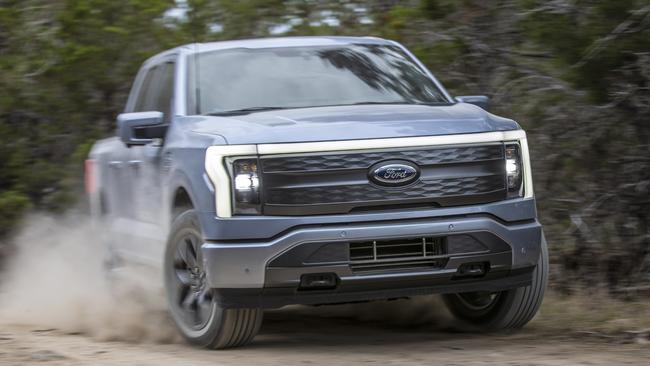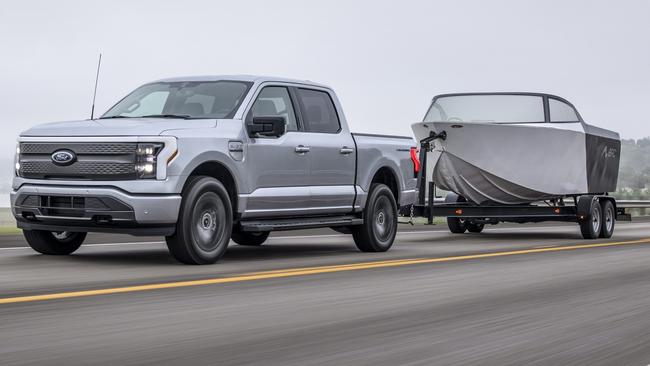Ford F150 Lightning first drive review
We get to sample Ford’s controversial new ute to see if it can live up to the standard set by diesel-powered workhorses. READ FULL VERDICT HERE.

Motoring News
Don't miss out on the headlines from Motoring News. Followed categories will be added to My News.
The runaway success of Ford’s F150 Lightning electric pick-up doesn’t have much to do with saving the planet, according to Ford’s EV communications manager, Emma Berg.
“There is not such a drive for sustainability in the US because frankly a lot of people don’t really care. But ultimately, the way you’re going to get them in is by giving them something that they’ve never had before.”

That something includes storing a couple of sets of golf clubs under the bonnet, powering your home or work tools and reaching 100km/h in a claimed four seconds.
Darren Palmer, Ford’s general manager of battery electric vehicles, says the company initially expected 40,000 orders for the Lightning in its first year on sale. It clocked up 220,000 before Ford was forced to close its order books to clear the backlog.
“If we turned it back on tomorrow, we’d probably get another 100,000,” Palmer says.
After a short drive of the Lightning through suburban Detroit, it’s easy to see the appeal.
Firstly, there’s the performance.

Plant the accelerator and almost three tonnes of metal launches at the horizon at breakneck speed. Testing suggests the big Ford will reach 100km/h in roughly 4.5 seconds, which is appreciably quicker than the petrol versions.
The Lightning comes standard with two motors – one on each axle for all-wheel-drive – and a choice of two batteries.
The standard range version with 98kW battery can travel 370km between charges and puts out 337kW/1050Nm, while the extended range model is good for up to 515km and puts out 433kW.

That means the Lightning should make short work of carrying a load or towing a trailer, although independent testing suggests range drops markedly when towing.
The Ford is comfortable for a big pick-up truck, gliding effortlessly over corrugations and road joins. It’s also surprisingly stable through the corners, thanks to the weight of the battery and its relatively low centre of gravity for a ute.
Our test drive was mostly at suburban speeds and you’d expect the truck to make its weight and size known on tighter corners. The suspension is also relatively soft and takes a moment to settle after larger bumps taken at higher speed.

Steering is slightly numb but predictable and the brake feel is good for an electric car. You can choose to leave the regenerative braking function off for a more normal pedal feel, or turn it on and save on brake pads and discs by using the electric motor to slow the truck in traffic.
In contrast to our diesel-powered best selling utes Down Under, the Lightning’s cabin is a serene place to spend some time. Road noise is well suppressed and you feel ten-foot-tall and bulletproof sitting so high above the bitumen.
Big comfy seats, acres of elbow room and myriad storage options make it an enticing mobile office for tradies. Rear passengers are well looked after as well, with their own air vents and plenty of head and leg room. Everything is super-sized, from the gear shifter to the centre console and the tablet-like centre touchscreen.

Ford has retained some buttons and knobs but most of the functions are controlled via menus on the touchscreen, which is reasonably easy to navigate.
A digital display in front of the driver can be configured to look like traditional analog dials or pared back to show only speed and range.
Despite its size the Ford is reasonably easy to park and manoeuvre, although American streets and carparks are more pick-up friendly than Australian ones.
Practicality is the Lightning’s strong suit. The rear seats can be flipped up to liberate more lockable load area, while there are ten three-pin power-points and 12 USB outlets.
The massive “frunk” under the bonnet can carry as much cargo as a small SUV.

The chief engineer of the Lightning, Linda Zhang, says the frunk has been a big drawcard, particularly with customers who had never considered a pick-up truck before.
“We’d talked to a lot of customers previously that didn’t choose the truck and tried to understand why and dry lockable storage was pretty much the main reason, so this really fixes a lot of that,” she said.
It also removed a “pain point” for existing truck owners, who complained about the lack of lockable storage space for groceries in the petrol F150.

Ford won’t say whether the Lightning will make it to Australian shores, but it seems unlikely in the near term. The Blue Oval will start selling converted F150s locally in the middle of next year, but will need time to bed down that operation before looking at additional variants.
FORD F150 LIGHTNING EXTENDED RANGE VITALS
PRICE More than $100,000 (est)
MOTOR Twin-motor, 420kW and 1050Nm
SAFETY Six airbags, auto emergency braking, lane-keep assist, blind-spot alert and rear cross-traffic alert
RANGE 483km
0-100KM/H 4.5 seconds





